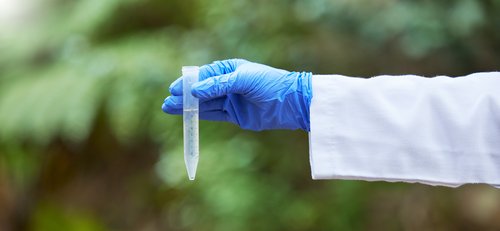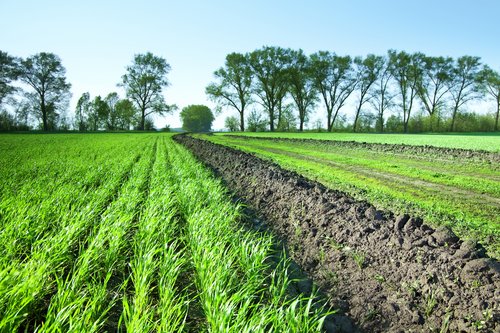
Mass spectrometry-based chromatographic analytical methods will be evaluated and established for soil and water. Analytical methods will be based on current developed, but also new methods will be developed. Additionally, degradation (DT50) and sorption (Kd) of NIs will be determined and possible transformation products (TPs) identified with high-resolution mass spectrometry.
This work package is led by Ulla E Bollmann (GEUS). Sorption and degradation studies will be performed by Ulla E. Bollmann and Christian Albers (GEUS), and the search for potential transformation products (TPs) will be performed by Ulla E. Bollmann with input from all project partners and the advisory board.
Leaching of NIs will be tested using a column leaching testing facility with temperature control, located at GEUS. Stainless steel columns will be driven into the top 30 cm of two different soil types (coarse and fine sand) using hydraulic tools to obtain semi-undisturbed soil columns. The leachate will be analyzed using LC MS/MS techniques developed in WP1. By the end of the study any remaining concentrations within the soil will be quantified and a mass balance of the analyzed NI’s and potential degradation products will be calculated.
This work package is led by Christian Nyrop Albers (GEUS) with Carsten S. Jacobsen (AU) as a contributing partner.

Field plots will be established on the same fields where soil is collected and used in WPs 1 and 2. The natural field experiment with real conditions is needed for testing side effect of nitrification inhibitors. The plots will form the basis of the analysis of the biological effects of NIs on microbial community, nitrification genes and ecosystem services; to be addressed in WPs 4 and 5. These analyses will be based on RNA extracted directly from soil collected in liquid nitrogen. This extraction method preserves RNA stability and allows for extensive analysis of both rRNA and mRNA as outlined in WPs 4 and 5. The same soil samples will further be used for both argeted and non-targeted analysis of soil to quantify the residual NI content and possible metabolites formed in the soil using the techniques developed in WP1.
This work package is led by Cecilie Skov Nielsen (SEGES). Contributing partners from KU and AU: Anders Prieme (KU), Postdoc NN (KU) (also working in WP4), Carsten Suhr Jacobsen (AU), Lea Ellegaard-Jensen (AU), Martin Hansen (AU), Anne Winding (AU), and Postdoc NN (AU). All contributing partners will participate in the planning of the field experiments and sampling protocols. The Postdoc at KU will be the main link between SEGES, AU and KU for sample transfer coordination and will contribute (in the 2-year field study) to sampling, which is led by SEGES.
The biological system that drives the nitrification process is analyzed in detail by quantitative PCR analysis of gene transcripts. This will be done using specific primers targeting denitrification, nitrification, and ammonia oxidation. We hypothesize that NIs have both direct and indirect effects on the expression by soil microorganisms of N cycling genes. WP4 will test this overall hypothesis by performing RT-qPCR on genes involved in the key steps of nitrification and denitrification.
Work package 4 is led by Anders Prieme (KU), with contributing partners Postdoc NN (KU), Cecilie Skov Nielsen (SEGES), Carsten Suhr Jacobsen (AU), and Lea Ellegaard-Jensen (AU).
The amoA project also focuses on the problem that NIs might hamper important soil ecosystem functions and decrease soil biodiversity. In WP5 we will analyze the RNA extracts from WP4 using high throughput sequencing on both rRNA and mRNA. The sequencing will be performed on Illumina platform and data analyzed using established bioinformatics pipelines. The rRNA will show changes in the biodiversity of soil microbial populations: these potential changes in the soil microbiome community composition will be measured by simultaneous to sequence the full pool of RNA, and then assemble sequences into contigs prior to annotation using taxonomic databases. In this way we will obtain an unparalleled insight into not only the bacterial populations, but also the archaea, fungi, and protists – all working together in the soil and all having a role in the overall biodiversity of the soil. Using rRNA sequencing we will collect valuable data on potential impacts of NIs on soil biodiversity. Using mRNA sequence data, the up- and down-regulated genes (mRNA) will be pinpointed and assessed. To achieve this, the mRNA sequences will be annotated to functions using broad databases as well as specialized ones (e.g. CAZy; Carbohydrate-Active enZYmes Database and NCycDB for N cycle genes). Following, the annotated count tables will be analysed for differential gene expression using the DESeq2 package in R. We suggest that statistically significant suppression on mRNA level of any other functional genes than nitrification genes with more than 50% downregulation in at least two measuring points after application of the nitrification inhibitor. The project will herby enable a thorough, targeted evaluation of unwanted effects of NI use on the agricultural soil ecosystems.
This work package is led by Lea Ellegaard-Jensen (AU), with contributing partners Postdoc NN (AU), Carsten Suhr Jacobsen (AU), Martin Hansen (AU), Anne Winding (AU), and Anders Prieme (KU).

This WP will address the need for an environmental impact evaluation of the chemical compounds introduced into the soil ecosystem. The WP will lead to a much-needed recommendation of whether existing NIs are safe to use with regards to both groundwater purity and soil microbial health. For this, we will collect chemical study findings and data from WP1, WP2 and WP3 to evaluate the overall environmental impact of NIs by integrating soil dissipation, degradation, sorption and leaching. Following environmental guidelines, we will evaluate the impact of NIs on soil microbial health and make recommendations. We will evaluate environmental quality using gene changes studies from WP4 and WP5 as input for the impact assessment, with special focus of the genes involved in N-cycling. It is expected community gene expression changes are observed to maintain homeostasis to compensate for environmental stress.
This WP is led by Martin Hansen (AU), with all other project partners contributing and the LBST and DK EPA representative in the advisory board.
This WP is essential to bring together the learnings and progress from the preceding WPs into an actionable solution that is brought into practice on a broad scale. The purpose of this WP is in ensuring that the Impact Evaluation Framework developed and demonstrated in this project will be taken up by the agriculture industry as well as regulatory bodies, and scaled to other parts of the world. In the first task of this work package the project partners will reach out to regulatory bodies in Denmark and across Europe, with the goal of establishing a regulatory network for the use of NIs. This will be done via established networks among European Environmental Research Institution (DCE is a member of the PEER network), as well as through the Danish agencies (Landbrugsstyrelsen and Miljøstyrelsen).
Further, outreach to the wider Danish and international agriculture industry via sessions at established events and organizing workshops is intended to aid in the dissemination of the research developed in amoA. These events will not only lay the ground for the adoption of the eventual framework, but may also be used to input into development process itself to ensure the highest likelihood of widespread adoption. This work package is driven by Arla, and theirs and Danish Crown’s network of industry contacts and influence will help secure attention internationally for the use of NIs and the related findings of the amoA project. Finally, the main goal of the project will be realized, resulting in the publication of the final framework.
This WP will be led by Arla under the leadership of Thorkild Qvist Frandsen (Arla). To enable a more international reach of the project’s impact via strong international networks, DCE at AU will be a partner for implementation via influence through the PEER network and JRC, and all partners’ involvement in the Zero-emission fertilizer network will also be leveraged here.

The project manager will ensure that the project progresses in a timely manner and that the deliverables and milestones are met. Each partner is responsible for the recruitment, particularly of postdocs, but the project manager will confirm the timely hiring of qualified staff. The project leader will initiate networking contacts throughout Europe and US to secure that the results from the project are given the maximal international influence.
This WP will be led by Carsten Suhr Jacobsen (AU), with support from Lea Ellegaard-Jensen (AU) and Mariane Schmidt Thøgersen (AU).